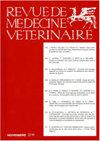Comparison of two injectable anesthetic combinations used to perform midline laparotomy for embryo recovery in Colombian creole ewes
Q2 Veterinary
引用次数: 2
Abstract
In the countryside, the use of halogenated anesthetics is difficult, therefore the use of injectable agents is an essential tool in anesthetic practice. This study aimed to compare two multimodal injectable anesthesia protocols and to determine the appropriate protocol to perform a medial laparotomy and embryo recovery in sheep. 16 healthy adult creole sheep were used. Animals were randomized to receive xylazine 0.2 mg/kg PC IM and ketamine 10 mg/kg PC IV (XK group), or a continuous infusion of 5% solution of xylazine (50 mg), ketamine (500 mg), and guaifenesin (500 mL) at a rate of 2.2 mL/kg/h IV (XKG group). Heart and respiratory frequency, rumen motility, and body temperature were evaluated before anesthesia, after induction, and during recovery. Induction was assessed by muscle spasms, nystagmus, and limb movement. Anesthesia was evaluated based on time, mandibular relaxation, skin sensitivity, and reflexes. Recovery was evaluated on a scale for anesthetic agent (0-10). Cardiorespiratory parameters decreased below baseline after induction of anesthesia in both groups. Between the groups, there was a significant difference in decubitus time (XK: 9.06 ± 0.73 min; XKG: 7.81 ± 0.53 min) and recovery (XK: 53.13 ± 5.3 min; XKG: 98.38 ± 5.71 min). Changes in the cardiopulmonary system were similar in both anesthetic regimens, and they were within acceptable clinical range. It is concluded that, in short surgical procedures, xylazine-ketamine anesthesia provides rapid induction, maintenance of physiological parameters within optimum limits, and rapid recovery.两种注射麻醉药组合用于哥伦比亚克里奥尔母羊中线剖腹手术胚胎恢复的比较
在农村,使用卤代麻醉药是困难的,因此使用注射药物是麻醉实践中必不可少的工具。本研究的目的是比较两种多模态注射麻醉方案,并确定在绵羊中进行剖腹手术和胚胎恢复的合适方案。选取16只健康成年克里奥尔羊。随机给予木嗪0.2 mg/kg PC IM和氯胺酮10 mg/kg PC IV (XK组),或以2.2 mL/kg/h IV的速率连续输注5%木嗪(50 mg)、氯胺酮(500 mg)和愈创甘油醚(500 mL) (XKG组)。在麻醉前、诱导后和恢复期间评估心脏和呼吸频率、瘤胃运动和体温。诱导通过肌肉痉挛、眼球震颤和肢体运动来评估。根据麻醉时间、下颌松弛、皮肤敏感性和反射进行评估。以0-10分的麻醉药物评分评估恢复情况。两组患者麻醉诱导后心肺参数均降至基线以下。两组间躺卧时间差异有统计学意义(XK: 9.06±0.73 min;XKG: 7.81±0.53 min)和回收率(XK: 53.13±5.3 min;XKG: 98.38±5.71分钟)。两种麻醉方案对心肺系统的影响相似,均在临床可接受范围内。结论:在短时间手术过程中,氯胺酮-氯胺酮麻醉可快速诱导,维持最佳范围内的生理参数,并快速恢复。
本文章由计算机程序翻译,如有差异,请以英文原文为准。
求助全文
约1分钟内获得全文
求助全文
来源期刊

Revue De Medecine Veterinaire
农林科学-兽医学
CiteScore
1.30
自引率
0.00%
发文量
0
审稿时长
18-36 weeks
期刊介绍:
The Revue de Médecine Vétérinaire publishes four kinds of text:
1) Scientific reviews on subjects related to veterinary and comparative medicine. Suggested length: 10 to 30 typed pages.
2) Original reports on fundamental or applied research. Suggested length: 10 to 15 typed pages.
3) Continuous education articles, that should be easily understandable by non-specialists. Suggested length: 10 to 15 typed pages.
4) Clinical reports. Suggested length: 5 to 15 typed pages.
The publication can be done in French language or English language.
For an article written in English by not english native speakers authors, the manuscript must be subjected by attesting that it was read again by an anglophone scientist or a scientific translator.
The authors must certify that the manuscript was not published or subjected for publication to another review.
The manuscript must be accompanied by a sheet signed by all the joint authors indicating their agreement for the tender of the manuscript.
The publication is free but a financial participation could be required for the photographs color. An estimate will be sent to collect the agreement of the authors.
 求助内容:
求助内容: 应助结果提醒方式:
应助结果提醒方式:


